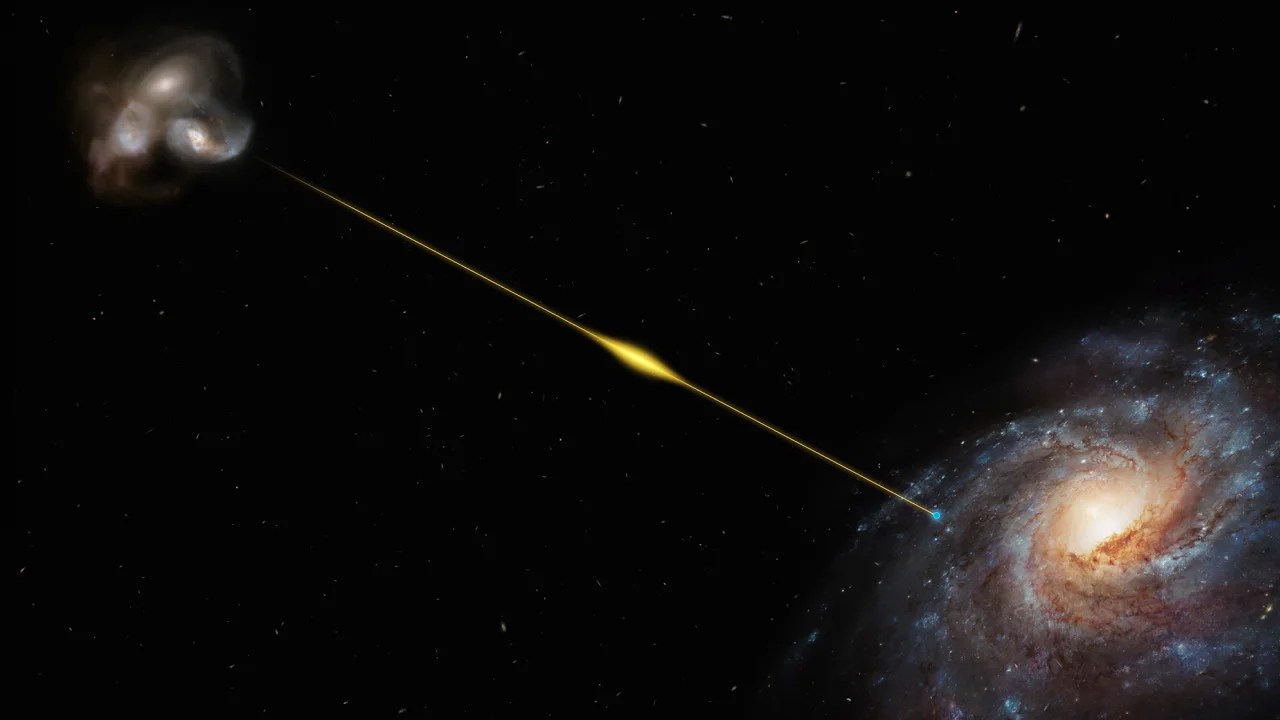(CNN) — Astronomers have discovered a mysterious burst of radio waves that took 8 billion years to reach Earth. The fast radio burst is one of the most distant and energetic explosions ever observed.
Fast radio bursts (FRBs) are intense, millisecond-long bursts of radio waves of unknown origin. The first FRB was detected in 2007, and since then hundreds of these fast cosmic flashes have been detected from distant points across the universe.
The explosion, dubbed FRB 20220610A, lasted less than a millisecond, but in that portion released the equivalent of energy emissions from our sun over 30 years, according to a study published Thursday in the academic journal. Sciences.
Many FRBs emit extremely bright radio waves that last for a few milliseconds at most before fading out, making FRBs difficult to observe.
Radio telescopes have helped astronomers track these rapid cosmic flashes, including the ASKAP radio telescope array in Wagari-Yamaji Prefecture, Western Australia. Astronomers used ASKAP to detect fast radio bursts in June 2022 and determine where they originated.
“Using ASKAP’s array of (radio) dishes, we were able to pinpoint the source of the explosion,” Dr. Stuart Ryder, co-author of the study and an astronomer at Macquarie University in Australia, said in a statement. “We then used the European Southern Observatory’s Very Large Telescope in Chile to search for the source galaxy, and found that it was older and (more distant) than any other FRB discovered so far and perhaps within a small group of galaxies. Fusion.”
The team of researchers traced the explosion to what appeared to be a group of two or three galaxies in the process of merging, interacting, and forming new stars. This result is consistent with current theories that suggest that fast radio bursts may come from magnetars or high-energy objects produced by exploding stars.
Scientists believe that fast radio bursts may be a unique way to weigh the universe by measuring unknown matter between galaxies.
“If we count the amount of natural matter in the universe – the atoms of which we are composed – we discover that more than half of what should be present today is missing,” co-author Ryan Shannon said in a statement of the study. Professor at Swinburne University of Technology (Australia). “We think the missing matter is hiding in intergalactic space, but it may be so hot and diffuse that it is impossible to see with normal techniques.”
So far, the results of current methods used to estimate the mass of the universe do not agree with each other, suggesting that the scale of the entire universe is not included.
“Fast radio bursts detect this ionized material,” Shannon explains. “Even in space that is almost completely empty, they can see all the electrons, and this allows us to measure the amount of matter between galaxies.”
this road The late Australian astronomer Jean-Pierre Macquart demonstrated how to use fast radio bursts to detect missing matter in 2020.
Ryder said Macquart “showed that the further (after) a fast radio burst, the greater the diffusion of gas between galaxies. This is now known as the Macquart relationship.” “A few recent fast radio bursts appear to have severed this relationship.
“Our measurements confirm that the Macquart connection extends far beyond the middle of the known universe.”
To date, approximately 50 fast radio bursts have been tracked to their origin points, and about half of them have been found using ASKAP.
“Although we still don’t know what causes these massive bursts of energy, the research confirms that fast radio bursts are common events in the universe and that we can use them to detect intergalactic matter and better understand the structure of the universe.” Shannon said.
Astronomers said they expect future radio telescopes, currently under construction in South Africa and Australia, to be able to detect thousands of fast radio bursts at greater distances.
“The fact that fast radio bursts are so common is also surprising,” Shannon said. “It shows how promising this field can be, because you won’t just do it for 30 bursts, you can do it for 30,000 bursts, creating a new map of the structure of the universe and using it to answer the big questions in cosmology.”

“Proud web fanatic. Subtly charming twitter geek. Reader. Internet trailblazer. Music buff.”

:quality(85)/cloudfront-us-east-1.images.arcpublishing.com/infobae/TEQF6EONZRFGLLLDIDD4L2O4EE.jpg)

:quality(75)/cloudfront-us-east-1.images.arcpublishing.com/elcomercio/XU32LRAEZFDDPNVHLFU3CKVBYY.jpg)



More Stories
How to create 3D videos with my iPhone, it will be very useful even for your business
NASA discovers an anomaly in the Earth’s magnetic field that could have serious consequences for humans
Can the Earth be divided into two parts?